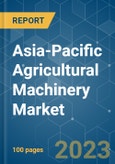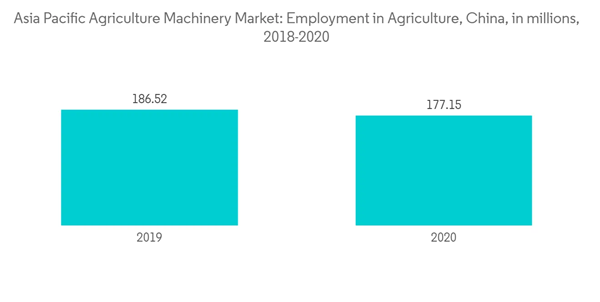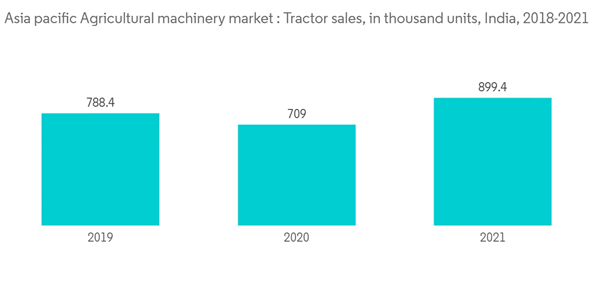Key Highlights
- The shrinking labor force and increased awareness among farmers regarding advanced agricultural practices are the prime reasons for the demand for agricultural machinery. Furthermore, the rise in technological advancements in agriculture equipment, and an increase in demand for pre-owned agriculture equipment, is likely to accelerate the revenue share. Additionally, population growth and high demand for agricultural products, primarily from countries, like India and China, are also aiding the growth of the market.
- China and India dominate the regional markets for agricultural equipment due to their enormous areas of arable land and low levels of automation, despite Japan having the greatest level of mechanization among the Asian nations. Australia is also a major market for agricultural equipment in the Asia-Pacific region. According to the Tractor and Machinery Association of Australia (TMA), the backing of the Instant Asset Write-off scheme increased sales of small tractors in Australia. In 2020-21, the tractor under 40 horsepower (30 kilowatts) increased by 72% for the month and completed the year 36% ahead. The growing emphasis on farm mechanization and governments' push for mechanization may enhance sales and lead to innovations, such as driverless machinery, which may drive the market throughout the forecast period. On the other hand, the lack of skilled professionals and the high cost of machinery are the key constraints of the market.
APAC Agricultural Machinery Market Trends
Lack of Farm Labor and Increase in Farm Wages
The cost of farm labor is directly proportional to the cost of production. Hence, increasing labor wages and lack of farm labor are driving the agriculture machinery market in the Asia-Pacific region. For instance, the average rise in the daily farm wages noticed in India is USD 0.2 in the last few years. This trend is anticipated to continue further as farm labor is decreasing because of the migration of rural people to urban regions.Moreover, a higher proportion of the population depends on agriculture on average in developing nations like China. Since many individuals move to urban regions every year, the percentage has dropped with time. For example, every year 0.5 to 1% decline is noticed in farm labor availability in China. Additionally, the Statistics from the Chinese government show that the percentage of people employed in agriculture fell from 36.7% in 2010 to 23.6% in 2020. The cost of farm labor is becoming more expensive as a result of the decline in agricultural labor. Similar to how inadequate rural reforms result in a reduction in rural labor, farmers are increasingly mechanizing their numerous farm operations. This is one of the major driving factors of agricultural machinery.
India and China Dominates the Market
India and China account for 60% of farm machinery share in the Asia-Pacific region. The demand for farm mechanization in India and China has continuously increased significantly. The prime market drivers are the lack of labor, the need to increase farm productivity, contract farming, and government incentives. A high labor wage is also a key factor in the market. Tractors occupy the major part of the market share among all the farm machinery in this region. Agriculture equipment sales dominated the Indian market in 2020, accounting for 810,000 units sold. China was the second largest market, accounting for 610,000 sales.Along with this, the Indian government provides incentives in the form of subsidies, cheap import levies on agricultural machinery, and simple financing schemes, which push the farmers to make their farms mechanized. Farm mechanization has become more common among farmers due to labor scarcity. There is a labor shortage in rural areas due to widespread migration from rural to urban areas and several rural employment programs. For instance, the National Rural Employment Guarantee Agency (NREGA) caused a cascade effect that resulted in farm mechanization in several locations due to a lack of labor.
Moreover, the support from the Chinese government is increasing farm mechanization for various crops, such as rice, wheat, corn, potato, oilseed rape, cotton, and sugarcane. The Chinese Ministry of Finance awarded more than CNY 20 billion in central government subsidies to acquire agricultural machinery in 2020. The country intends to achieve 75% full mechanization of agriculture, plowing, planting, and harvesting by 2025. Additionally, China has launched the Made in China 2025 initiative, which seeks to produce 90% of the country's agricultural equipment with high-end machineries, such as agricultural tractors, which accounted for one-third of the market sector in 2020. This, in turn, stimulates locally built tractors and propels the agricultural tractor market in the country.
APAC Agricultural Machinery Market Competitor Analysis
The market is highly consolidated with the presence of a few prominent players, accounting for more than half of the market. New product launches, partnerships, and acquisitions are the major strategies adopted by the leading companies in the market studied. Deere & Company, AGCO Corp., International Tractors Limited (Sonalika), Kubota Tractor Corp., and Mahindra & Mahindra Ltd are some of the leading players in this region.Additional benefits of purchasing the report:
- The market estimate (ME) sheet in Excel format
- 3 months of analyst support
This product will be delivered within 2 business days.
Table of Contents
Companies Mentioned (Partial List)
A selection of companies mentioned in this report includes, but is not limited to:
- Deere and Company
- AGCO Corp.
- CNH Industrial NV
- Kubota Corporation
- Mahindra & Mahindra Ltd
- Yanmar Company Limited
- International tractors limited
- Iseki & Co. Ltd
- Escorts Limited
- AMAZONEN-Werke H. Dreyer GmbH & Company KG
- YANMAR Co. Ltd
- Netafim Limited










